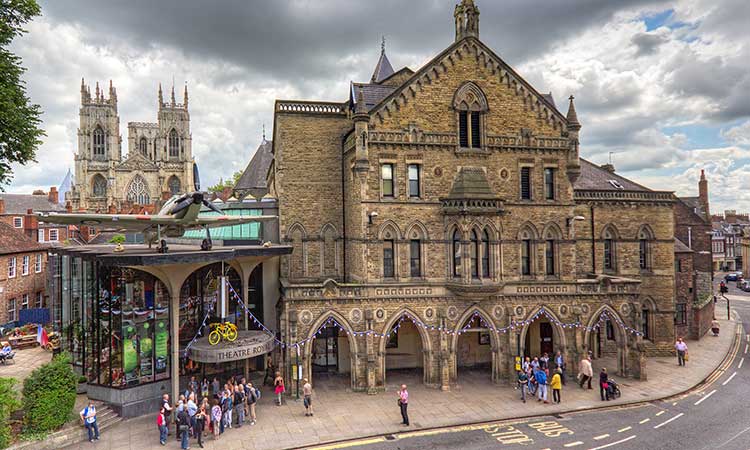
The suitably dramatic headlines include:
- York Theatre Royal temporarily moving out of its home on St Leonard’s Place and moving to a bespoke-built 1,000-seater auditorium behind the National Railway Museum
- a nine-month renovation which will see the stage levelled and rebuilt and a new glazed colonnade added
- the creation of Britain’s first International Shakespeare Festival
- a re-staging of the hugely popular Railway Children at the NRM.
Off to the railway museum
York Theatre Royal will close after the RSC Schools Festival on Monday, March 16, 2015.
It will reopen in time for the pantomime, which would be expected to start at the end of November 2015.
During that time York Theatre Royal productions will be staged at the National Railway Museum.
A temporary 1,000 seater auditorium will be created in the sidings of the south yard at the Leeman Road museum.
“It’s a fantastic opportunity,” said director of the NRM Paul Kirkman.
“We are both in the business of telling stories. Ours are about the history of railways and what they mean to the people of York and the people of Britain.
“We can learn so much from the experience of storytelling of the Theatre Royal.”
Liz Wilson, theatre chief executive, said: “I think it’s a hugely significant national approach for two organisations from different parts of the artistic and cultural spectrum to work together.
“We’ll have lots to learn from each other.”
New stage, new stalls
Thanks to a £2.9 million award from Arts Council England – the most significant investment in the theatre since the 1967 foyer extension – York Theatre Royal can go ahead with its £4.1 million redevelopment project.
A £500K award from City of York Council and other funding has seen it raise £770,000 of the remaining sum, leaving it a little under half a million to find over the next year or so.
During its eight month closure from March 2015, the foyer space will be enlarged, the auditorium reconfigured and refurbished and the whole building made more accessible.
Key parts of the project
- the glazing-in of the colonnade and opening up the space around what is now Exhibition Corridor to create new and more spacious welcome areas
- the reconfiguration of the stalls and the stage to create much better views for audiences
- the addition of a foyer lift to improve access and new seating areas for wheelchair users in the Dress Circle.
How the new York Theatre Royal will look
The work is also designed to make the theatre more green, and to increase its income streams – for example, the café will be enlarged and improved.
Plans to improve the rake of the stalls and flatten the stage will be particularly beneficial to children coming to the theatre, who have sometimes struggled to see shows from the stalls said artistic director Damian Cruden.
It will also enable more than the current two trapdoors to be built in the stage, offering set designers and directors much more flexibility.
Berwick Kaler will reopen the theatre with his 2015 panto.
“I have talked to Berwick about it – there aren’t going to be the same seats in the stalls he’s been used to for 38 years,” said Damian.
“He said, ‘that’s fantastic – I can’t wait for it’. We’re really only doing it so it’s easier for Berwick!”
Shakespeare Festival
Liz Wilson announced that the Theatre Royal was working with the University of York to launch Britain’s first International Shakespeare Festival.
“We don’t have an International Shakespeare Festival in this country but they have them all over Europe.”
The first one would run in May 2015. “It would start in a small way and grow,” she said.
Railway Children steams back
The Theatre Royal’s relationship with the NRM began when it staged an adaptation of The Railway Children at the museum in 2008.
The Olivier award-winning show later transferred to Waterloo Station in London.
It will return during the theatre’s stay at the NRM in 2015.
The two partners are also working on a brand new community play about York’s railway history. It has the working title Steam.
Like the hugely successful Blood + Chocolate it will see local people working alongside professionals, and the show will “explore the museum’s on-site collections in innovative and exciting ways”.
Building on history
A theatre has been operating on this site since 1744, although parts of the building date much further back.
Angus Morrogh-Ryan, the lead architect on the redesign, said the theatre had been updated to suit new audiences throughout its history.
Researching the project, “we were amazed to find in a salt mine in Cheshire 600 drawings and manuscript documents that chronicle how the building has changed over time”.
Underneath the stage are said to be remnants of Roman foundations. The Keregan Room of the theatre is set among the 13th century remains of St Leonard’s Hospital.
The old theatre today is a “Georgian core on a medieval base” Angus said. Then the Victorians built the Gothic stone facade before the Edwardians increased the size of the house.
Then came the 1967 glass foyer by Patrick Gwynne, very much ahead of its time.
“What we’re providing now is utterly consistent with this history, and prepares the theatre for its future,” Angus said.
Theatre boss Liz Wilson said they want to create “an experience that was commensurate with the big theatres in London. The people of York deserve a theatre as good as you get anywhere in the country.”
A main aim was to ensure more York residents used the theatre. “We hope our city and citizens can get on board and celebrate the ambitions we have for the organisation and the site.”


